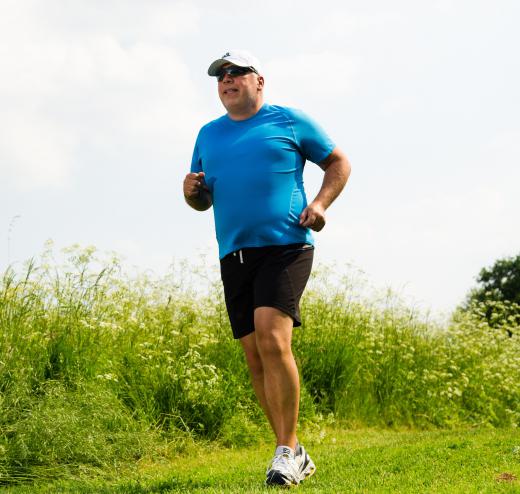At Sports&Hobbies, we're committed to delivering accurate, trustworthy information. Our expert-authored content is rigorously fact-checked and sourced from credible authorities. Discover how we uphold the highest standards in providing you with reliable knowledge.
What is a Pedometer?
A pedometer, sometimes also called a “stepometer,” is an electronic device that calculates the number of steps a person has taken. Most are relatively small and are designed to fit inside a pocket or clip onto a belt, and will sense the wearer's movements and count the steps based on hip movement. Most will then convert those steps into a measurable distance, though this usually involves calibration to the wearer’s stride length if it’s going to be accurate. People frequently wear these devices as a way of motivating themselves to walk more often, or as a means of measuring distance covered while going about ordinary day-to-day activities. There are a number of different styles and models available in most places. They can range from basic display-only devices to complicated machines that synch to smartphones and weight loss websites. The basic premise of counting steps is the same no matter the specifics, though.
How it Works

Most pedometers work by sensing vibration and the swinging motion of the hips that happens whenever a person walks or runs. This is the main reason they’re worn on or near the waist: they are actually measuring the movement that happens in the leg sockets with each step. This is normally done through a combination of electronic sensors and basic gears on the inside of the device. In most cases, calculating steps taken is pretty easy. The devices can’t usually measure intensity, however, which is to say that steps walked at a slow gait usually register the same as those jogged or even sprinted.

Many models are also able to convert steps taken into distance covered, typically in miles, kilometers, or both. There is some room for error here unless the devices are carefully calibrated to the user’s specific stride. Someone with very long legs may cover significantly more ground with a single step than would someone with much shorter legs, though an uncalibrated stepometer might show the same distance for each. This can be avoided by programming the device to the user’s exact stride length. The exact process for this varies by device, but in most cases it isn’t very difficult.
Models and Styles

The most basic pedometers are simple battery-operated boxes with little more than a display screen and an on/off switch. Some can store data from multiple days, but many are reset each time they’re turned off. Models in this category are usually quite inexpensive, and can be good choices for people who don’t need or want any sort of serious tracking.

There are many different options, though. Fancier models can store step counts from days or even weeks and years past, which can give people a good way to track their progress over time. Many modern devices can also be synched up to other technology including phones and websites. In this way, the devices can become part of a larger workout or fitness regimen, and data can be seamlessly transferred and inputted from one place to the next.
Popularity

Many health professionals say that walking is one of the best forms of exercise, and it’s also something that’s relatively easy for most people to incorporate into their daily lives. Pedometers are often the most popular with individuals who want to walk more but aren’t sure how they’ll fit it in to their lifestyles. Wearing one of these devices will count even everyday steps, like up and down the stairs or from the office to the car, and watching the numbers go up can encourage people to do things like park a bit farther away or walk down the hallway one more time in order to stay on target. These may seem like small things, but over time they can lead to better health and even weight loss.
General Usage Tips
Most experts offer three basic tips for people interested in using one of theses devices. It’s usually a good idea to begin by setting a baseline by wearing the device but not doing anything out of the ordinary. Doing this for about a week can give a person a general sense of how much walking he or she does naturally.
Then, the person should set a goal. He or she should try to increase the first week of walking activity by approximately 20%. The wearer can create a walking routine that will help reach this goal and write down the results each day, or track them in the device or online.
Finally, users are encouraged to strive for what’s known as “maximum potential.” Each week, the person should continue to add onto the goal for the number of steps he or she takes. Most fitness specialists recommend that a person try to get to between 6,000 to 10,000 steps a day in order to get the most benefit. Being realistic here is really important, though. For most people, adding just a few steps each day can improve both mental and physical health, but visible results can take months or even years to appear. The people who have the most success with these devices take them for what they are — just one tool in a larger arsenal of health and fitness resources.
AS FEATURED ON:
AS FEATURED ON:















Discussion Comments
I have a pedometer that sits in the drawer along with other gadgets that I thought I couldn't live without. Reading this article has motivated me to get it back out and use it again though.
My lifestyle is pretty sedentary as I sit in front of the computer all day long. In the evening I don't have much energy to exercise so find myself plopping down on the couch in front of the TV.
I realize I need to be more active and do like to set goals for myself. One thing I liked about using the pedometer was you could see your progress at any time. If something as simple as a pedometer can make me more aware of taking more steps throughout the day, I really need to get it out and start using it again.
I wore a pedometer for awhile but got out of the habit. I am very active during the day chasing three young children around so I don't usually have any trouble taking a lot of steps throughout the day. When we went to Disneyland I took my pedometer with me. I was curious to see how many steps I walked each day around the park. One day I had walked almost 18,000 steps, which is twice as much as I usually walk in one day. By the end of the day my legs and back also felt like I had walked that many steps.
When I have my pedometer clipped on I don't even know it is there. It is quiet and I usually forget about it until I take it off at the end of the day to see how many steps I have walked. This was a free pedometer I got at a health fair and it is one of the best freebies I have ever received.
@anon24969 -- I was also amazed at how something so simple could be so motivating for me. My goal was to get to 10,000 steps a day and I looked for ways to add this to my daily routine.
Instead of driving around for 2-3 minutes looking for a close parking space, I would park at the back of the lot and walk those extra steps. It probably even took me less time to do that than driving around hoping to find a close spot.
I made other choices like taking the stairs instead of an elevator or escalator. Simple changes like this can make a big difference in the number of steps you take every day. It didn't take me long to reach my goal, and now my goal is to make sure I take 10,000 steps every day.
I know some people claim that the vast majority of pedometers are inaccurate because they count the number of steps without knowing the length of your stride. Some people have a short stride while others bound around like gazelles. Without knowing how much distance the stride consumes, it is impossible to know how far the runner has traveled.
Think of a distance discrepancy of just 6 inches. Over the course of a long run with thousands of steps that distance would add up pretty quickly and give you a skewed result.
I bought a cheap pedometer to use when I run but it ended up annoying me so much that I stopped using it. Every time I took a step it made this quiet little clicking noise. After a mile or two the sound started to drive me crazy. It was so methodical that it made me very conscious of myself while I ran, which any runner will tell you is the fastest way to get annoyed with running. I think if I had invested a little more money I could have gotten a model without such an audible action.
I've been using Pedometer Ultimate gps +. It is very useful. I can connect my iPhone with sensors and adapters produced by 60beat, Wahoo Fitness or Runalyzer. There are a lot of useful features that can help you to be slimmer. As a motivator, you can use the daily goal and calories burner bar.
All my results I can share via sms, e-mail, 60beat, Wahoo Fitness or Runalyzer. And moreover, I can track my route in my and see all routes I passed. I consider the Pedometer Ultimate GPS + to be the best pedometer iOS app. And the main feature is that Pedometer Ultimate GPS + is absolutely free.
I recently purchased a pedometer, let me tell you it works great. Its small and easy to wear, it has motivated me in so many ways just seeing the calories just makes you want to walk, walk, and walk some more.
I think it is a good investment. It makes you aware of how many steps you have made during the day. I think it might actually help us stay fit.
There are quite a few options on the market. Some count steps only, others will do a song and dance for you. My philosophy is the the simpler the better. You want it to be lightweight and accurate though.
Post your comments